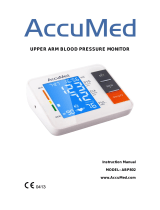
2
GB
HOMEDICS BLOOD PRESSURE MONITOR
Before use
Before the blood pressure monitor is taken into use, a number of basic steps should be observed. Please read
this manual thoroughly before the blood pressure monitor is used for the first time and keep the manual for
future use.
The blood pressure monitor is intended for home use only. Any measurement is solely for your information
and can under no circumstances replace a visit to the doctor. The blood pressure measurements should
always be assessed by a qualified person (a doctor, nurse or similar) who is familiar with the user’s general
medical condition. By regular use and by keeping a record of the results, this person can be kept well
informed about developments in the user’s blood pressure. Measurements must never be interpreted by the
user with the aim of changing levels in the use of medicine as prescribed by a doctor. The doctor’s
instructions must be followed AT ALL TIMES.
Use of appropriate cuff size is crucial to correct measurement. Follow the instructions presented in this
manual and printed on the cuff to ensure that the correct cuff size is used.
The blood pressure monitor is not suited for users who suffer from arrhythmia (heart rhythm disturbances)
and errors may occur in the measurement results if the user has suffered a stroke, suffers from cardiovascular
diseases, has a very low blood pressure, or suffers from other symptoms such as circulatory diseases (diabetes,
kidney diseases, arterial sclerosis (deposits in the arteries), or poor peripheral blood circulation (e.g. in hands
and feet).
Electromagnetic disturbances: The device contains sensitive electronic components. Keep it clear of strong
electric or electromagnetic fields in the immediate surroundings (e.g. mobile telephones, microwave ovens)
as these may temporarily reduce measurement accuracy.
Use the blood pressure monitor only for its original purpose.
The device is intended for measurement of blood pressure and pulse with adult persons. Do not apply the
monitor to infants nor to persons who cannot express their permission. The device must not be operated by
children.
The blood pressure monitor functions in accordance with the oscillometric measurement principle. These
blood pressure changes are measured in the cuff on the basis of the arm pulse and are converted into a
numerical value of the current blood pressure. Simultaneously, the number of pulse beats are registered and
calculated as number of pulse beats per minute.
There are two kinds of discernible blood pressures. Both are expressed in mmHg (millimetres on the mercury
column): The systolic and the diastolic. The systolic (‘the high blood pressure’) states the pressure when the
heart chambers contract to send blood through your body, and the diastolic (‘the low blood pressure’) states
the pressure when the heart is at ease and filling with blood before the next muscle contraction. The
connection between values (mmHg) is expressed as e.g. 130 over 85 which means that the systolic pressure is
130 and the diastolic pressure is 85.
Why is it important to keep an eye on your blood pressure?
Many of today’s most common diseases are connected to hypertension , also referred to as ‘high blood
pressure’. Hypertension is closely connected to cardiovascular diseases, and for people in the danger zone the
blood pressure provides an important tool to keep an eye on the development.
IB-BPA2000-0912-01:Layout 1 09/01/2013 17:50 Page 2






















